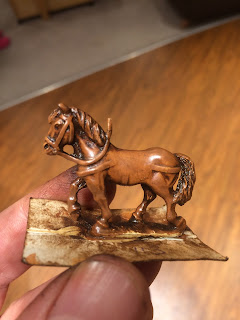Well for many years I have thought about doing this, it's kind of like the next level up on the painting horses scale, so I was keen to give it a go. At the moment I'm just jumping straight in and experimenting with colours and drying times etc. I read a little on line to give me some pointers but the best thing to do is get stuck in and get your hands messy.
The smell of the enamel took me straight back to painting D&D figures when I was 15, great stuff.
Out of all the colours I tried I think the chestnut Bay worked out the best. I'm off to buy some black Oil paint now and so will try that on the dark Bay colour to see what it will look like.Once I have worked out what works and what doesn't I will do a follow up post with some tips.
Not so keen on the Dun coloured horses but they still work, I think I will try some more browns and even a white or cream colour next. So far quite happy with the results and It gets a lot of horses painted quickly.








7 comments:
The horses look great, and I say "Oils? You're a brave man!"
I've put it off for many years but at the end of the day it's very easy. Although you have to plan ahead and be patient. The enamels take and day to dry and the Oils take up to three days to dry. Although if you do a batch of 15 plus horses it is a great way to bash through large amounts of horse flesh.
You seem to make the distinction between enamels and oils. I see Humbrol tins in the picture: I assume that those would be the enamels?
The reason I ask is that I paint with enamels (Humbrol and Model Master/Testors), and some of my friends refer to those as oils--but I don't think that is correct. True oils are something else.
Been a follower of your blog for quite some time, by the way. Excellent stuff!
Thankyou Ed, yes you are quite right Oil paints come in tubes and are of course meant for canvas. however painted onto enamel and then wiped off with tissue paper after five minutes gives great warm flesh tones. Still early days for me but I will let you know my findings and materials used when i know more.
I always have thought that the oil effect on horses was the best and most effective one to use, although I dont use it any more. I'm not patient enough. I found that Burnt Umber was the richest oil to use, and from picking the brains of several of Peter Gilder's painters they seemed to agree. Try experimenting with different coloured undercoats, I found deep yellows and oranges with Burnt Umber gave a wonderful effect. I also found that a babies flannelette sheet was the best material to wipe the oils off, I think its the fact it is so gentle.The effect using a piece of cheap sponge was too harsh.
Best of luck.
Thanks for the tips. I'm just so glad I'm doing it. I've been scared to try for years thinking there was some secret trick to it. Hopefully my findings will inspire others.
Yes I know what you mean the first night I tried a paper tissue which was good for wiping off the oil, second night I tried a bit of old T shirt and that took off oil and paint, sowas too harsh.
Post a Comment